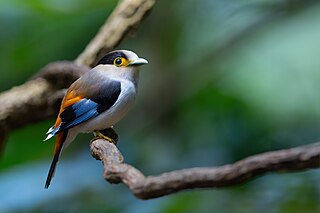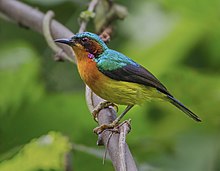
The brown-headed barbet is an Asian barbet species native to the Indian subcontinent, where it inhabits tropical and subtropical moist broadleaf forests.

The barred buttonquail or common bustard-quail is a buttonquail, one of a small family of birds which resemble, but are not closely related to, the true quails. This species is resident from India across tropical Asia to south China, Indonesia and the Philippines.

The greater racket-tailed drongo is a medium-sized Asian bird which is distinctive in having elongated outer tail feathers with webbing restricted to the tips. They are placed along with other drongos in the family Dicruridae. They are conspicuous in the forest habitats often perching in the open and by attracting attention with a wide range of loud calls that include perfect imitations of many other birds. One hypothesis suggested is that these vocal imitations may help in the formation of mixed-species foraging flocks, a feature seen in forest bird communities where many insect feeders forage together. These drongos will sometimes steal insect prey caught or disturbed by other foragers in the flock and another idea is that vocal mimicry helps them in diverting the attention of smaller birds to aid their piracy. They are diurnal but are active well before dawn and late at dusk. Owing to their widespread distribution and distinctive regional variation, they have become iconic examples of speciation by isolation and genetic drift.

The common iora is a small passerine bird found across the tropical Indian subcontinent and Southeast Asia, with populations showing plumage variations, some of which are designated as subspecies. A species found in scrub and forest, it is easily detected from its loud whistles and the bright colours. During the breeding season, males display by fluffing up their feathers and spiral in the air appearing like a green, black, yellow, and white ball.

The capped wheatear is a small insectivorous passerine bird that is widely distributed over southern Africa. It was formerly classed as a member of the thrush family Turdidae, but is now placed in the Old World flycatcher family, Muscicapidae.

The Mascarene swiftlet or Mauritius swiftlet is a species of swift in the family Apodidae. It is found in Mauritius and Réunion, and the populations on the two islands have recently been confirmed to differ subspecifically. The nominate race francicus is found on Mauritius and the recently described race saffordi occurs on Réunion. Its natural habitats are subtropical or tropical moist lowland forest, subtropical or tropical high-altitude shrubland, subtropical or tropical high-altitude grassland, caves, arable land, and heavily degraded former forest. It is threatened by habitat loss.

The lesser coucal is a species of cuckoo in the family Cuculidae. It has a wide distribution range that overlaps with several other similar species. The habitat in which it is found is often marshy land with grass and tree cover. It is distinguished by its smaller size, less prominent bill, pale shaft streaks on the feathers of the head and back. It has a much longer claw on its hind toe and a distinct call. It is also among the few coucals that show season plumage differences but like in other coucals, the sexes cannot be distinguished in the field.

The Asian emerald cuckoo is a species of cuckoo in the family Cuculidae. It is found in Bangladesh, Bhutan, Cambodia, China, India, Indonesia, Laos, Malaysia, Myanmar, Nepal, Sri Lanka, Thailand, and Vietnam. Its natural habitats are subtropical or tropical moist lowland forests and subtropical or tropical moist montane forest.

The cream-vented bulbul is a member of the bulbul family of passerine birds. It is found in south-eastern Asia from the Malay Peninsula to Borneo. Its natural habitat is subtropical or tropical moist lowland forests. Its breast might sometimes look a little yellow.

The straw-headed bulbul is a species of songbird in the bulbul family, Pycnonotidae. It is found from the Malay Peninsula to Borneo. Its natural habitats are subtropical or tropical moist lowland forest, subtropical or tropical mangrove forest, subtropical or tropical moist shrubland, arable land, plantations, and rural gardens. It is threatened by habitat loss and poaching.

The thick-billed green pigeon is a species of bird in the family Columbidae.

The scarlet-backed flowerpecker is a species of passerine bird in the flowerpecker family Dicaeidae. Sexually dimorphic, the male has navy blue upperparts with a bright red streak down its back from its crown to its tail coverts, while the female and juvenile are predominantly olive green. It is found in subtropical or tropical moist lowland forests and occasionally gardens in a number of countries throughout South and East Asia.

The snowy-browed flycatcher is a species of bird in the Old World flycatcher family Muscicapidae.

The short-crested flycatcher is a species of bird in the tyrant flycatcher family Tyrannidae.

The silver-breasted broadbill is a species of bird in the broadbill family, Eurylaimidae that is found in parts of Southeast Asia. There are seven currently recognised subspecies; the other species in the genus Serilophus, the grey-lored broadbill, was also previously treated as being a subspecies of this species.

The grey-throated babbler is a species of passerine bird in the Old World babbler family Timaliidae.

The large woodshrike is found in south-eastern Asia, Sumatra, Java, and Borneo. Its natural habitats are temperate forest, subtropical or tropical moist lowland forest, subtropical or tropical mangrove forest, and subtropical or tropical moist montane forest.

Van Hasselt's sunbird, is a species of bird in the family Nectariniidae. It is found in Northeast India, Bangladesh and Southeast Asia. Its natural habitats are subtropical or tropical moist lowland forests and subtropical or tropical mangrove forests.

The eastern yellow wagtail is a small passerine in the wagtail family Motacillidae, which also includes the pipits and longclaws. It was often classified as a subspecies of the Western yellow wagtail. It breeds in the eastern Palearctic and Alaska and migrates to South Asia and Australia.

The plume-toed swiftlet is a small bird in the swift family Apodidae. It is found on some eastern Indian Ocean islands, the Malay Peninsula, Sumatra, and lowland Borneo.






















